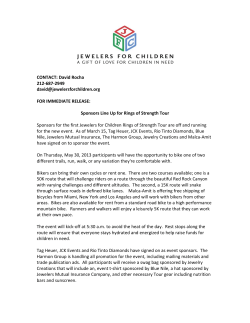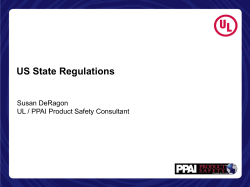
California’s Metal-Containing Jewelry Law Fact Sheet, February 2012
Fact Sheet, February 2012 California’s Metal-Containing Jewelry Law The Department of Toxic Substances Control (DTSC) is responsible for enforcing California’s law to protect children and adults from exposure to lead and cadmium in jewelry.1 The law restricts the amount of lead in jewelry by identifying what materials may be used and setting lead concentration thresholds that may not be exceeded. The law also restricts the amount of cadmium allowed in children’s jewelry. This fact sheet has been developed to help consumers and people in the jewelry industry understand the law and its requirements. Background Jewelry, including inexpensive children’s jewelry, can contain dangerously high levels of lead and cadmium. Lead is a toxic metal that can cause serious health effects, ranging from behavioral problems and learning disabilities to organ failure, and even death. Chronic cadmium ingestion can lead to kidney damage, bone loss problems, vomiting, diarrhea and even death at high enough doses. Children six years old and under are most at risk, because their bodies are growing quickly. Jewelry that contains toxic metals poses a particular concern because children are prone to placing jewelry in their mouths, which can result in dangerous amounts of toxic metals getting into their bloodstreams. Recalls of lead and cadmium contaminated jewelry sold in places such as discount stores, gift shops and vending machines have increased people’s awareness of the health hazards associated with toxic metals in jewelry. The tragic death of a four year-old child in Minnesota after he swallowed a jewelry charm containing lead underlined the importance of taking immediate action to ensure the public is protected from this danger. Because of concerns about the risks they pose, California enacted laws that restrict the lead and cadmium content in jewelry. These laws together comprise California’s Metal-Containing Jewelry law.2 This law prohibits persons from manufacturing, shipping, selling, or offering for sale jewelry for retail sale, or for promotional purposes, in California unless the lead and cadmium restrictions are met. 1 Please note that all children's products, including jewelry, are subject to the lead restrictions in the federal Consumer Product Safety Improvement Act (CPSIA), which defines “children” as 12 years old and younger. For more information about the Federal lead requirements for children’s products please visit the following website: Consumer Product Safety Improvement Act of 2008 (CPSIA) Information. For a summary of the CPSIA requirements pertaining to lead in children's products, including lead in paint, go to http://www.cpsc.gov/ABOUT/Cpsia/summaries/101brief.html. 2 Health and Safety Code sections 25214.1-25214.4.2 1 Applicability This law applies to those who manufacture ship, sell, or offer for sale jewelry for retail sale, or offer jewelry for promotional purposes, in California. Businesses of all sizes are subject to the law, including but not limited to: large retail "box" stores; online stores and Web sites; discount stores; bead shops; craft stores; gift shops; souvenir stores; businesses that sell children's jewelry in vending machines; tattoo shops; body piercing shops; people who make and sell their own jewelry; video arcades; and mail order companies. All jewelry is subject to the lead restrictions set forth in the law. All children’s jewelry is subject to the cadmium restriction set forth in the law. Definitions • “Jewelry” means: (1) Any of the following ornaments worn by a person: anklet; arm cuff; bracelet; brooch; chain; crown; cuff link; tie clip; hair accessory; earring; necklace; pin; ring; body piercing jewelry; jewelry placed in the mouth for display or ornament; (2) any bead, chain, link, pendant or other component of an ornament specified in (1) above; (3) a charm, bead, chain, link or pendant attached to shoes or clothes, that can be removed; or (4) a watch in which a timepiece is a component of an ornament specified in (1) above, excluding the timepiece itself if the timepiece can be removed from the ornament. • “Children’s Jewelry” means jewelry made for, marketed for use by, or marketed to children ages six and younger. • “Body Piercing Jewelry” means any part of jewelry that is manufactured or sold for placement in a new piercing or a mucous membrane, but does not include any part of that jewelry not placed within a new piercing or a mucous membrane. Note: for the purposes of this law, the parts of body piercing jewelry not placed within a new piercing or a mucous membrane are considered to meet the more general definition of “jewelry” and are regulated as such. Requirements The Metal-Containing Jewelry Law regulates the levels of lead and cadmium in jewelry in California by specifying both materials that can be used and restrictions on lead and cadmium in the materials and the jewelry. Please refer to the attached table of materials for an explanation of Class 1, 2, and 3 materials. Specific requirements for children’s jewelry, body-piercing jewelry, and adult jewelry are described below. 2 Children’s Jewelry must be made from one or more of the following: (1) A nonmetallic material that is a Class 1 material and that does not otherwise violate the requirements of paragraph (4). (2) A nonmetallic material that is a Class 2 material. (3) A metallic material that is either a Class 1 material or contains less than 0.06 percent (600 parts per million) lead by weight. (4) Glass or crystal decorative components that weigh in total no more than one gram, excluding any glass or crystal decorative component that contains less than 0.02 percent (200 parts per million) lead by weight and has no intentionally added lead. (5) Printing ink or ceramic glaze that contains less than 0.06 percent (600 parts per million) lead by weight. (6) Class 3 material that contains less than 0.02 percent (200 parts per million) lead by weight. In addition to the limitations listed above, no component or material used in children’s jewelry may exceed 300 parts-per-million (ppm) cadmium by weight. Body-Piercing Jewelry (the component of jewelry that is placed in a new piercing or a mucous membrane) must be made from one or more of the following: (1) Surgical implant stainless steel. (2) Surgical implant grade of titanium. (3) Niobium (Nb). (4) Solid 14 karat or higher white or yellow nickel-free gold. (5) Solid platinum. (6) A dense low-porosity plastic, including, but not limited to, Tygon or Polytetrafluoroethylene (PTFE), if the plastic contains no intentionally added lead. All Other Jewelry – must be made from Class 1, Class 2, or Class 3 materials, or a combination thereof. Certification A manufacturer or supplier of jewelry subject to this law must provide certification that the jewelry is in compliance with the law’s lead and cadmium restrictions. The manufacturer or supplier must either provide this certification to the person who sells this jewelry, or display the certification prominently on the shipping container or jewelry packaging. Additionally, the manufacturer or supplier of jewelry subject to this law must, upon request from DTSC and within 28 days, provide to DTSC technical documentation or other information showing that the jewelry is in compliance with the law 3 Inspections Under California’s Lead-Containing-Jewelry Law, DTSC has the authority to enter and inspect a factory, warehouse, or other establishment where jewelry is manufactured, packed, held or sold, or a vehicle used to transport, hold, or sell jewelry. DTSC is also authorized to obtain a sample, in exchange for a receipt for the item, and to review all relevant records. Penalties A person who violates the law may be subject to civil penalties up to $2,500 per day per violation. A manufacturer or supplier who knowingly and intentionally manufactures, ships, sells, offers for sale, or offers for promotion jewelry in violation of the law, may be fined between $5,000 and $100,000, or imprisoned up to a year, or both. A manufacturer or supplier who knowingly and with intent to deceive falsifies any document or certificate required by the law can be fined up to $50,000, or imprisoned up to a year, or both. Test Methods for Determining Compliance The Metal-Containing Jewelry law requires the use of EPA Methods 3050B, 3051A, or 3052 [found in EPA Test Methods for Evaluating Solid Waste, Physical/Chemical Methods, SW846 (Third Edition, as currently updated)] to determine compliance. The manufacturer or supplier must use the most appropriate test method for total digestion of the sample. The law also specifies additional sample preparation and testing procedures for certain materials. See California Health and Safety Code sections 25214.4 and 25214.4.1. A list of certified environmental laboratories is provided on the California Department of Public Health website. Caution: This fact sheet does not replace or supersede statutes or regulations. All jewelry manufacturers, distributors, suppliers, and retailers must follow the hazardous waste control statutes and any implementing regulations applicable to their activities. 4 For more information: Please visit our Web sites at: Lead in Jewelry and Cadmium in Children's Jewelry email us at: leadinjewelry@dtsc.ca.gov or call us at: (916) 322-3670 You may also contact the Regulatory Assistance Officers at 800-728-6942 (800-72-TOXIC) or RAO@dtsc.ca.gov. 5 Jewelry Material Classes* Class 1 Materials: Stainless or surgical steel; karat gold; sterling silver; platinum, palladium, iridium, ruthenium, rhodium, or osmium; Natural or cultured pearls; Glass, ceramic, or crystal decorative components, including cat’s eye, cubic zirconia, cubic zirconium (CZ), rhinestones, and cloisonné; Gemstones cut and polished for ornamental purposes (excluding aragonite, bayldonite, boleite, cerussite, crocoite, ekanite, linarite, mimetite, phosgenite, samarskite, vanadinite, and wulfenite); Elastic, fabric, ribbon, rope, or string (unless it contains intentionally added lead and is listed as a class 2 material); All natural decorative material, including amber, bone, coral, feathers, fur, horn, leather, shell, wood, that is in its natural state and is not treated in a way that adds lead; and Adhesive. Class 2 Materials: Electroplated metal: o On and before August 30, 2009, a metal alloy <10% lead by weight electroplated with suitable under and finish coats. o After August 31, 2009, a metal alloy <6% lead by weight electroplated with suitable under and finish coats; Unplated metal <1.5% lead not otherwise listed as a class 1 material; Plastic or rubber, including acrylic, polystyrene, plastic beads and stones, and polyvinyl chloride (PVC): o On and before August 30, 2009, <0.06% (600 ppm) lead by weight o After August 31, 2009, <0.02% (200 ppm) lead by weight; and A dye or surface coating containing <0.06% (600 ppm) lead by weight. Class 3 Materials: Any portion of jewelry that meets both of the following criteria: Not a class 1 or class 2 material Contains <0.06% (600 ppm) lead by weight Note that Class 2 and Class 3 materials carry lead restrictions. *Pursuant to Health and Safety Code sub-sections (e), (f), and (g) of section 25214.1. 6 Materials Required for Jewelry, by Type of Jewelry Jewelry Type Children’s jewelry (Made for, marketed for use by, or marketed for children ages 6 and younger.) Body Piercing Jewelry (Any part of jewelry that is manufactured or sold for placement in a new piercing or a mucous membrane) All other jewelry Materials Required -- Jewelry Must Be Made Entirely From One or More of the Materials Listed for Each Jewelry Type A nonmetallic class 1 material* A nonmetallic class 2 material* A metallic material that is either a class 1 material* or contains <0.06% (600 ppm) lead by weight. Glass or crystal decorative components that weigh in total no more than 1 gram, excluding any glass or crystal decorative component that contains <0.02% (200 ppm) lead by weight and has not intentionally added lead. Printing ink or ceramic glaze that contains <0.06% (600 ppm) lead by weight. Class 3 material* that contains <0.02% (200 ppm) lead by weight. Surgical implant stainless steel Surgical implant grade of titanium Niobium (Nb) Solid 14 karat or higher white or yellow nickel-free gold Solid platinum Dense low-porosity plastic, including, but not limited to, Tygon or Polytetrafluoroethylene (PTFE), if the plastic contains no intentionally added lead. Class 1 material* Class 2 material* Class 3 material* *See classes of materials on previous page. Note: No material may exceed 0.03% (300 ppm) cadmium by weight. 7
© Copyright 2025














